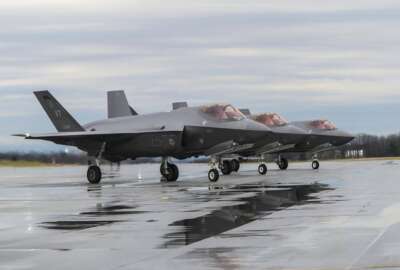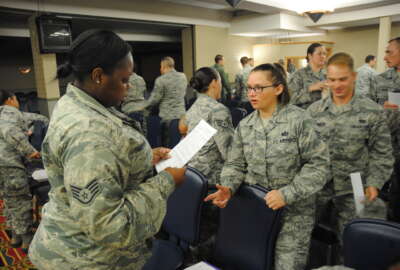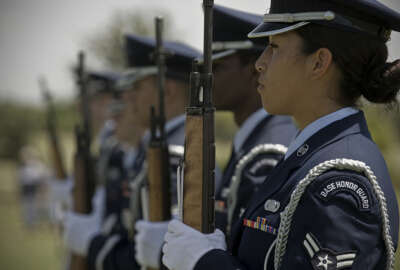One National Guard unit’s idea to improve efficiency: spend less time filling out forms
A Virginia National Guard thinks it's found a way to save the Air Force hundreds of thousands of man hours each year just by auto-filling a single form.
For several years now, the Air Force, at its most senior levels, has recognized its policies and procedures have a strong tendency to force airmen to misspend their time on ancillary tasks instead of the ones they signed up for.
The service has had some success at reducing distractions like excessive computer-based training and performance evaluations, but it’s done less in the arena of bureaucratic administrivia. Things like paperwork.
Just like many other government agencies, the Air Force’s internal processes live and breathe via forms that have to be filled out manually, and each one takes time. How much? That was a difficult question to answer until the Virginia Air National Guard’s 192nd Wing saw a chance to do things differently.
“The information we were filling out on these forms was very repetitive: ‘Who’s your supervisor? What’s your social security number?’ And everything that they need to know on all these forms is already known about us. There’s technology out there that should be pre-populating this information,” said Chief Master Sgt. Joseph Young, who helped launch just such a technology solution while he served as the 192nd Operations Group’s senior enlisted leader. Young now serves as the senior enlisted leader for wing inspections, and has stayed involved in the process.
Early results from what the wing calls “HR Smart Weapon” are extremely promising. Its back-of-the-envelope math, based on a fair amount of real-world testing, suggests the Air Force could save about 156,000 person-hours per year if the approach they’re experimenting with was deployed across the whole service. And that’s for just one form.
The initial idea grew out of an Air Force initiative that tries to find “airmen-led” ideas that might cut costs, improve readiness, or give airmen back some of the time they waste on non-value-added tasks. Assisted by AFWERX, the service’s main innovation arm, the program allocates tens of millions of dollars each year to what the Air Force calls squadron innovation funds.
Young said the paperwork streamlining idea first came up during a training event in Las Vegas for how to spend those funds effectively. There, airmen were asked to pitch ideas, and the time suck surrounding manual form filling quickly emerged as the biggest pain point for the 192nd’s attendees.
“Even though they’re digital forms, it’s still paperwork,” he said during an interview for Federal News Network’s On DoD. “We have a particularly difficult time with the onboarding process. It can take upwards of three months from the time a person shows up for them to get their initial paycheck, in particular, for people who are coming from different organizations that are already in the military. No particular office is the problem. It’s the paperwork and the disparate databases that are involved, and they don’t necessarily talk quickly to one another. So we were trying to solve that problem.”
AFWERX suggested using a Small Business Innovative Research (SBIR) solicitation to ask vendors for help, and after whiteboarding the problem with several of them, the wing settled on Tackle AI, an Illinois-based firm that focuses its work on exactly this issue but had never done government work before.
“They specialize in extracting data from unstructured documents, so they could take all of our legacy forms, ingest them into their AI algorithm, and then create profiles for each individual,” Young said. “So the next time somebody would bring up a form, this profile information is automatically populated. And whenever the database didn’t know something about you from the ingest process, it would ask the user for that information. And once a user provided that information, you wouldn’t need to provide it again in the future.”
But it took a fair amount of back-and-forth between the 192nd’s testing team and TackleAI’s engineers to get the concept working for the Air Force’s needs. That’s partly because the wing wanted the technology solution to not just help fill out the forms, but also track their progress through each office who needed to view, approve, and send them up the paperwork chain.
They pulled that off too, Young said, and it was important that they did. After all, the inefficiency of the current, paper-centric system isn’t just a pain for the airman who first fills out a given form. Supervisors and various other approving officials need to see and sign off on them, and right now, that’s mostly done via PDFs attached to emails.
“Email is a terrible place to track things. Things get lost all the time, you have to sort through what’s important and what’s not, and it’s easy for things to fall through the cracks, especially when you’re trying to route and coordinate things. HR Smart Weapon makes it easy by showing you, ‘Hey, it’s got to go to these five offices, and this is the person who approved it at the previous office,” Young said. “So it helps you not only save time, but you can do analytics and see clearly whether a certain office is getting backlogged. Then, the commander can make decisions to shift resources to plus-up that office with additional personnel so they can be more efficient, or we can look into other ways of continually improving that process.”
The wing’s initial tests, or what it called a “bake-off” between the current, manual paperwork process, and the AI-assisted one, appeared to show concrete time savings: 35 minutes versus 20 minutes per form, on average.
And the forms were more accurate, which is key too. A simple typo in a manually-entered field can cause the whole form to get kicked back to the last person who approved it. Those kinds of errors happened 12% of the time under the manual process, but 0% of the time with HR Smart Weapon.
Granted, the tests were extremely small scale. Only five forms were tested for each method, and it’s extremely likely the broader Air Force would want to see much more testing before scaling it up. HR Smart Weapon would also need to make its way through various other approval gauntlets, like earning an authority to operate on DoD networks, no small feat.
Young said his team understands all that. It’s just a proof-of-concept for now, but one that’s worth the Air Force’s attention. And he acknowledged that even if the approach gets approved for operational use, there are going to be cultural adaptations needed too, partly around the question of whether commanders will be willing to trust algorithms to fill in boxes that used be completed by highly-trained human beings, no matter how mundane those box-filling exercises really are.
“I fully expect people to be hesitant, he said. “Even myself, it’s going to take me a little bit longer initially, because I’ll want to double check everything before I hit ‘submit.’ But if we have a level of confidence that this does what it says it does, and it’s accurate, I mean the sky’s the limit. As soon as we add more forms to it, we’re going to have that level of trust that it is filling out accurate and current information. That will help reduce time and give it back to our airmen and our commanders to do what matters most, and that’s to be in front of your airmen and not be encumbered with all of this paperwork. We can get after the mission by doing less paperwork.”
Copyright © 2025 Federal News Network. All rights reserved. This website is not intended for users located within the European Economic Area.
Jared Serbu is deputy editor of Federal News Network and reports on the Defense Department’s contracting, legislative, workforce and IT issues.
Follow @jserbuWFED






